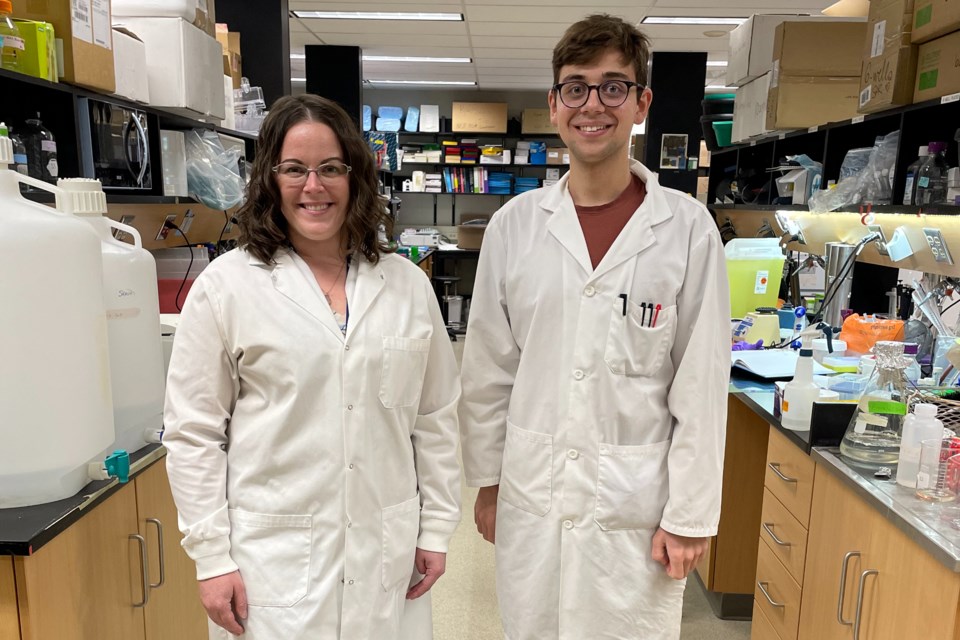Glioblastoma is an aggressive form of brain cancer, with a survival rate of about five per cent.
It’s notoriously resistant to traditional treatments like chemotherapy, radiation and surgery, and has a high relapse rate. But a team of researchers at the University of Guelph is determined to change that.
Shaun Sanders is a neuroscientist and an assistant professor at the university. She and her team of researchers are looking into new treatments by studying the response glioblastoma creates in the GRP78 protein.
Essentially, the protein ends up in the wrong place in the tumour cell, compared to where it would be within a healthy brain cell, moving to the outer surface. There, it rapidly divides and grows, spreading the cancer, which is why it becomes so resistant to treatment.
“There has been some promising work in animal models, where they’ve been able to use an antibody to target the cell surface of GRP78. But that’s not a viable approach going forward because it’s hard to get into the brain where the brain cancer is,” Sanders said.
The protein is palmitoylated, meaning the cell has a “sticky tag” that acts like a postal code, directing it to the surface. This movement isn’t something that normally happens to GRP78; the researchers believe it’s a stress response in cancer cells.
Sanders' team is trying to find a way to keep the cell from moving to the surface with enzymes by targeting GRP78.
“Enzymes add the sticky tag, and there is another class of enzymes that remove it,” she said. They’re focusing on using enzymes because enzymes can be targeted with various drugs.
“The end goal is to develop a small molecule inhibitor that would then be able to be given to the patients.”
As far as she knows, they’re the only researchers in Canada looking at how the palmitoylation of GRP78 aids the spread and resilience of glioblastoma.
Currently, they’re working with tumour cell lines they can grow in a dish, but during the second year of the project she said they will be working with model brains to simulate the response to a tumour.
“We want to work in this really cool model system where we can grow mini-brains in culture, and then we can put a tumour in those mini brains, and watch how the tumour invades into the healthy brain tissue,” she said. “And if we stop that sticky tag from being added to GRP78, does that reduce the growth and invasion of the tumour into the healthy tissue?”
The brains are a relatively new technology made by culturing organ-specific tissue from stem cells – a big step from animal models, as they can replicate the human brain response to human-derived glioblastoma cells. The models will be developed by her colleagues, Nina Jones and Jasmin Lalonde.
“They have developed this model for other studies, so we’re taking advantage of having great colleagues next door to do that with our project,” she said. “It allows us to do work in a human system without actually having to go directly into humans.”
Over the years, Sanders has studied protein malfunctions involved in epilepsy and ataxia. She began looking at palmitoylation in 2007 as an undergraduate student, where she worked on a research project for Huntington’s disease.
But the idea to target palmitoylation in glioblastoma cells was brought to her by PhD student Andrey Petropavlovskiy.
“I've never really worked on glioblastoma before. We were working already in the lab on palmitoylation, together with the work he had done as an undergraduate on GRP78, so he kind of came with a unique perspective that I didn't have,” she said. “And we just went with it. So far, it’s been giving really interesting findings. Having all of us together, coming up with new ideas, makes science stronger. And, and we can go in directions that I never thought that I would go.”
Sanders said she hopes she can make a difference in people's lives with this research.
“That’s why I became a scientist," she said.
While it can take “quite a long time” from discovery to bedside, she hopes to be doing drug screening assay within the next five years or so, after which they would go to a drug company to develop it further.
